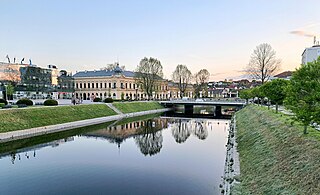
Vukovar is a city in Croatia, in the eastern regions of Syrmia and Slavonia. It contains Croatia's largest river port, located at the confluence of the Vuka and the Danube. Vukovar is the seat of Vukovar-Syrmia County and the second largest city in the county after Vinkovci. The city's registered population was 22,616 in the 2021 census, with a total of 23,536 in the municipality.

Vukovar-Srijem County, Vukovar-Sirmium County or Vukovar-Syrmia County, named after the eponymous town of Vukovar and the region of Syrmia, is the easternmost Croatian county. It includes the eastern parts of the region of Slavonia and the western parts of the region of Syrmia, as well as the lower Sava river basin, Posavina and Danube river basin Podunavlje. Due to the overlapping definitions of geographic regions, division on Slavonia and Syrmia approximately divides the county vertically into north-west and south-east half, while division on Posavina and Podunavlje divides it horizontally on north-east and south-west half.

Borovo, also known as Borovo Selo, is a village and a municipality in Vukovar-Syrmia County in eastern part of Croatia. Situated on the banks of the Danube river, it shares its border with Serbia and the municipality of Bač on the opposite side. The historical development of Borovo is intricately linked with the Danube, which has played a pivotal role in its development as a notable industrial hub in the region.

The Willesden United Synagogue Cemetery, usually known as Willesden Jewish Cemetery, is a Jewish cemetery at Beaconsfield Road, Willesden, in the London Borough of Brent, England. It opened in 1873 on a 20-acre (0.08 km2) site. It has been described as the "Rolls-Royce" of London's Jewish cemeteries and is designated Grade II on Historic England's Register of Historic Parks and Gardens. The cemetery, which has 29,800 graves, has many significant memorials and monuments. Four of them are listed at Grade II. They include the tomb of Rosalind Franklin, who was a co-discoverer of the structure of DNA.

The Battle of Vukovar was an 87-day siege of Vukovar in eastern Croatia by the Yugoslav People's Army (JNA), supported by various paramilitary forces from Serbia, between August and November 1991. Before the Croatian War of Independence the Baroque town was a prosperous, mixed community of Croats, Serbs and other ethnic groups. As Yugoslavia began to break up, Serbia's President Slobodan Milošević and Croatia's President Franjo Tuđman began pursuing nationalist politics. In 1990, an armed insurrection was started by Croatian Serb militias, supported by the Serbian government and paramilitary groups, who seized control of Serb-populated areas of Croatia. The JNA began to intervene in favour of the rebellion, and conflict broke out in the eastern Croatian region of Slavonia in May 1991. In August, the JNA launched a full-scale attack against Croatian-held territory in eastern Slavonia, including Vukovar.
The Vukovar massacre, also known as the Vukovar hospital massacre or the Ovčara massacre, was the killing of Croatian prisoners of war and civilians by Serb paramilitaries, to whom they had been turned over by the Yugoslav People's Army (JNA), at the Ovčara farm southeast of Vukovar on 20 November 1991, during the Croatian War of Independence. The massacre occurred shortly after Vukovar's capture by the JNA, Territorial Defence (TO), and paramilitaries from neighbouring Serbia. It was the largest massacre of the Croatian War of Independence.

Lovas is a village and seat of municipality in the Vukovar-Syrmia County of eastern Croatia, located on the slopes of Fruška Gora, a few kilometers south of the main road connecting Vukovar with Ilok. Lovas has a population of 1,214 (2011), and its municipality also includes the smaller village of Opatovac which is located to the north, at the Danube. Lovas is underdeveloped municipality which is statistically classified as the First Category Area of Special State Concern by the Government of Croatia.

A Jewish cemetery is a cemetery where Jews are buried in keeping with Jewish tradition. Cemeteries are referred to in several different ways in Hebrew, including beit kevarot, beit almin, beit olam [haba], beit chayyim and beit shalom.
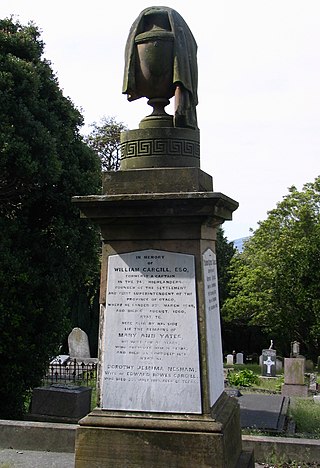
The Southern Cemetery in the New Zealand city of Dunedin was the first major cemetery to be opened in the city. The cemetery was opened in 1858, ten years after the founding of the city in an area known as Little Paisley. This area lies at the southern end of Princes Street, one of the city's main streets, close to the suburbs of Kensington, Maryhill, and The Glen.

Bobota is a village in the Municipality of Trpinja in Vukovar-Syrmia County in eastern Croatia. Regional Bobota Canal, the first major water management project in modern-day Croatia in the post-Roman Empire period, was named after the village.
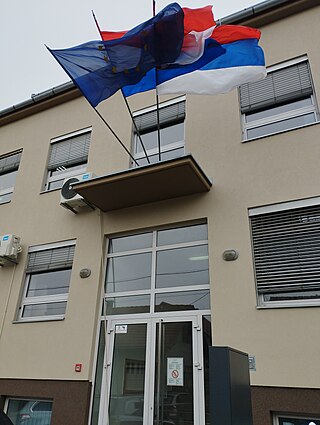
The Joint Council of Municipalities in Croatia is an elected consultative sui generis body which constitutes a form of cultural self-government of Serbs in the eastern Croatian Podunavlje region. The body was established in the initial aftermath of the Croatian War of Independence as a part of the international community's efforts to peacefully settle the conflict in self-proclaimed Eastern Slavonia, Baranya and Western Syrmia. The establishment of the ZVO was one of the explicit provisions of the Erdut Agreement which called upon the United Nations to establish its UNTAES transitional administration.
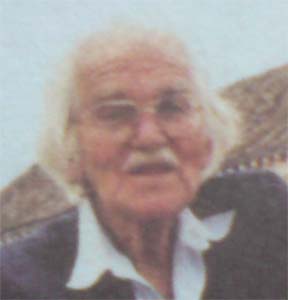
Alfred Pal was a Croatian painter and graphic designer.
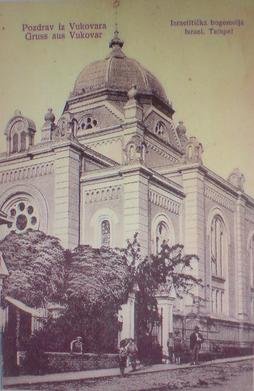
The Vukovar Synagogue, also the Great Vukovar Synagogue, was a former Neolog Jewish synagogue, located in Vukovar, Croatia. The synagogue was completed in 1889, in the Kingdom of Croatia-Slavonia, within the Austria-Hungary, after the first smaller synagogue was sold to the Calvinist church in 1910. The synagogue was devastated by the Nazis in 1941; and demolished in 1958.

Slavko Wolf was a Croatian lawyer, chess player and writer.

The Anti-Cyrillic protests in Croatia were a series of serbophobic protests in late 2013 against the application of bilingualism in Vukovar, whereby Serbian and the Serbian Cyrillic alphabet were assigned co-official status due to the local minority population. The implementation of this decision became mandatory after the 2011 Croatian census, according to which Serbs in Vukovar comprise more than one-third (34.8%) of Vukovar's total population. Signs in the Serbian Cyrillic alphabet had been put up as the Constitutional Act on the Rights of National Minorities mandates bilingual signs in any area where more than one-third of the population belongs to an ethnic minority. This decision became subject of intense agitation by, among others, Croatian war veterans and many ordinary citizens who believe that due to events, particularly the Battle of Vukovar, the city should have been excluded from the application of the law on minority rights, although protests and vandalism have occurred in other towns and cities. The Serbs of Croatia are a minority group that have the narrowest usage of right to bilingualism among all national minorities in Croatia.

The Serbs of Vukovar are one of traditional communities living in the multicultural, multi-ethnic and multi-confessional eastern Croatian town of Vukovar on the border with Serbia. The Serb community constitutes slightly over one third of the entire population of Vukovar according to 2011 Census. Other significant communities include the Croat majority, as well as Hungarians, Slovaks, Rusyns, Ukrainians and historically Yugoslavs, Germans, Jews, Vlachs and Turks.
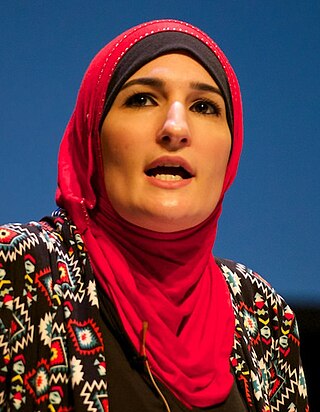
Linda Sarsour is an American political activist. She was co-chair of the 2017 Women's March, the 2017 Day Without a Woman, and the 2019 Women's March. She is also a former executive director of the Arab American Association of New York. She and her Women's March co-chairs were profiled in Time magazine's "100 Most Influential People" in 2017.

Vučedol Culture Museum is a museum of prehistoric culture in at Vučedol, near the city of Vukovar, Croatia.

The Jewish cemetery of Salonica was established in the late fifteenth century by Sephardic Jews fleeing the expulsion of Jews from Spain, covered around 350,000 square metres (3,800,000 sq ft) and contained almost 500,000 burials. The cemetery's expropriation was envisioned in the urban redevelopment plan following the 1917 Great Fire of Thessaloniki, but strongly opposed by the Jewish community as disturbing the graves violated Jewish law. The cemetery was ultimately destroyed in December 1942 by the municipality of Thessaloniki as part of the Holocaust in Greece during the Axis occupation of Greece. The headstones were used as building materials around the city, including for Greek Orthodox churches, while the Aristotle University of Thessaloniki was built on the grounds. The Jewish community never received compensation for the expropriation of the land, valued at 1.5 billion drachmas in 1943.
The Serbian Military Cemetery, also known as the Alejalit. 'Alley' among local Serbs and Šajkača Cemetery among local Croats, is a small military cemetery in Vukovar, town in eastern Croatia. The cemetery was built in 1994 on a plot of land next to the Old Orthodox Cemetery. The cemetery commemorates 26 Serbian soldiers killed during the Battle of Vukovar in 1991.























